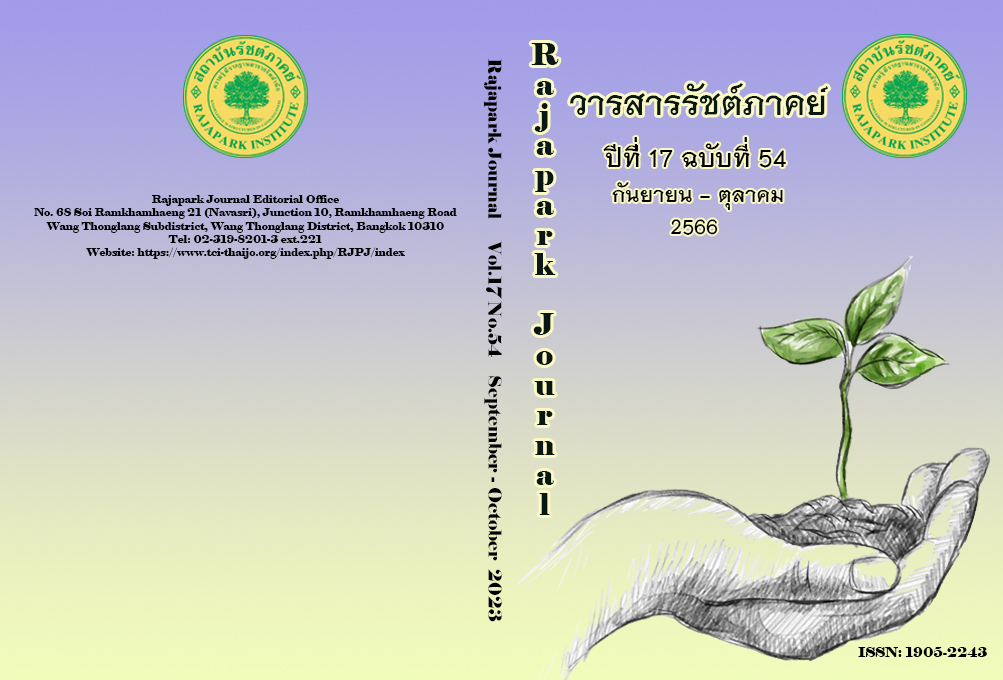Competitive Advantages Affecting the Performance of the Silverware Business in Thailand
Main Article Content
Abstract
The silverware business is a unique business that creates competitive advantages through the use of unique craftsmanship, according to the Thai Industrial Development Master Plan 2012–2031. The research aimed to study the relationship, focusing on effectiveness, between competitive advantage and the performance of the silverware business in Thailand. This was a quantitative study. The population used in this study were silverware business operators registered as juristic persons with the Department of Business Development in the Ministry of Commerce of Thailand, a total of 585 businesses. From the estimate of 20 times the variable from the research model with parameter 12, the sample number is 240 businesses, and there were 210 complete responses, accounting for 87.5%. The instrument for collecting data was a questionnaire. The analysis of data was done through descriptive statistical analysis and inferential statistical analysis. The research results were found to be as follows: Factors of business competitive advantage include cost leadership, cash flow management, general differentiation, and marketing and innovation differentiation. They influenced the performance factors in the same direction and also found that the factors of business competitive advantage can best forecast the performance of employees, followed by the performance of customers, with social performance next in order.
Article Details

This work is licensed under a Creative Commons Attribution-NonCommercial-NoDerivatives 4.0 International License.
Views and opinions appearing in the Journal it is the responsibility of the author of the article, and does not constitute the view and responsibility of the editorial team.
References
Abdulluh, A. L. (2017). The Impact of Distinctive Competencies and Competitve Advantages on Organizational Growth. University of Petra, Jordan.
Agha, S., Alrubaiee, L., & Jamhour, M. (2012). Effect of Core Competence on Competitive Advantage and Organizational Performance. International Journal of Business and Management, 7(1), 192-204.
Angsuchote, S., Wijitwanna, S., & Pinyopanuwat, R. (2014). Analytical Statistics for Social Science and Behavioral Science Research: LISREL Techniques (Chapters 1, 3, 6) (4th ed.) Charoendeemunkong.
Awang, A., Asghar, A. R., & Subari, K. A. (2010). Study of Distinctive Capabilities and Entrepreneurial Orientation on Return on Sales among Small and Medium Agro-Based Enterprises (SMAEs) in Malaysia. International Business Research, 3(2), 34-48.
Barney, J. B. (1991). Firm Resources and Sustained Competitive Advantage. Journal of Management, 17(1), 99-120.
Barney, J. B., & Hesterly, W. S. (2010). VRIO Framework. In Strategic Management and Competitive Advantage. Pearson.
Barney, J. B., Ketchen, D. J., & Wright, M. (2011). The Future of Resource-based Theory: Revitalization or Decline?. Journal of Management, 37(5), 1299-1315.
Camisón, C. (2003). Shared, Competitive, and Comparative Advantages: A Competence-based View of Industrial-district Competitiveness. Environment and Planning A, 36, 2227-2556.
Clarke, P., & O'Connor, R. (2011). The Meaning of Success for Software SMEs: A Holistic Scorecard Based Approach. In 18th European Software Process Improvement Conference, CCIS, 172, Springer-Verlag.
Dubey, R., & Ali, S. S. (2011). Study on Effect of Functional Competency on Performance of Indian Manufacturing Sector. Int. j. eng. bus. Manag, 3(3), 1-15.
Fehr, E., & Falk, A. (1999). Wage Rigidity in a Competitive Incomplete Contract Market. Journal of Political Economy, 107(1), 106-134.
Hitt, M. A., & Ireland, R. D. (1985). Corporate Distinctive Competence, Strategy, Industry and Performance. Strategic Management Journal, 6(3), 273-293.
Intharapong, S. et al. (2015). Strategic Guidance for Competitive Advantage in the Drugstore Business in Thailand. Journal of Public and Private Management, 65-90. https://so03.tci-thaijo.org/index.php/ppmjournal/article/download/60020/49305
Kaplan, R. S., & Norton, D. P. (1996). Strategic Learning & The Balanced Scorecard. Strategy & Leadership, 24(5), 18-24.
Krungsri Research. (2022). 2022-2024 Thailand Industry Outlook. https://www.krungsri.com/en/research/industry/summary-outlook/outlook-2022-2024
Man, M. M. (2009). The Relationship between Distinctive Capabilities, Strategy Types, Environment and the Export Performance of Small and Medium-Sized Enterprises of the Malaysian Manufacturing Sector. Management, 4(3), 205-223.
Marqués, D. P., Gacía, M. G., Sánchez, M. M., & Mari, M. P. A. (2019). Social Entrepreneurship and Organizational Performance: A Study of the Mediating Role of Distinctive Competencies in Marketing. Journal of Business Research, 101, 426-432.
Metheesuwapab, S., Sakulitsariyaporn, C., & Wijitwanna, S. (2015). The Influences of Key Success Factors on Thai Accounting Office Performance for Accommodating ASEAN Economic Community. Suthiparithat, 29(92), 254-272.
Ministry of Industry. (2011). Thailand Industrial Development Master Plan 2012-2031. http://www.oie.go.th/assets/portals/1/fileups/2/files/Industrial.%20Master%20Plan/National_Industrial_Development_Master_Plan.pdf
Montoya, J. O., Huerta, M., & Rialp, J. (2011). Marketing Managers as Firm’s Key Resource: Setting Their Distinctive Core Competencies through a Delphi. https://www.semanticscholar.org/paper/MARKETING-MANAGERS-AS-FIRM-%E2%80%99-S-KEY-RESOURCE-%3A-THEIR-Montoya-Huerta/8efc6912a7872bf6cf3126bd51757db05e53347d
National Economic and Social Development Board (NESDB). (2012, August 31). Reveals that Thailand Depends on Exports up to 70.50% of GDP. Posttoday. https://www.posttoday.com/finance-stock/news/174301
Nguyen, T. A. (2008). Functional Competencies and their Effects on Performance of Manufacturing Companies in Vietnam[Doctor of Economics and Social Sciences, University of Fribourg, Switzerland]. https://core.ac.uk/download/pdf/20645285.pdf
Office of Lifestyle Product Trade Promotion Department of International Trade Promotion. (2019). National Economic and Social Development Plan, No. 12, 2017-2021. https://www.thaitextile.org/th/insign/detail.460.1.0.html
Porter, M. E. (1985). The Competitive Advantage: Creating and Sustaining Superior Performance. Free Press.
Scapolan, A. (2017). Behavioral Competencies and Organizational Performance in Italian Performing Arts: An Exploratory Study. Academia Revista Latinoamericana de Administración, 30(2), 92-214.
Smart, D. T., & Conant, J. S. (1994). Entrepreneurial Orientation, Distinctive Marketing Competencies and Organizational Performance. Journal of Applied Business Research, 10(3), 28-38.
Sureshchandar, G., & Leisten, R. (2005). Holistic Scorecard: Strategic Performance Measurement and Management in the Software Industry. Measuring Business Excellence, 9(2), 12-29.
The Gem and Jewelry Institute of Thailand (Public Organization). (2019). Import-export Situation of Thai Gems and Jewelry in 2019. http://www.tpa.or.th/writer/read_this_book_topic.php?bookID=4408&pageid=1&read=true&count=true
The Gem and Jewelry Institute of Thailand (Public Organization). (2018). Identity Jewelry a Valuable Heritage of Thailand. https://infocenter.git.or.th/Content_View.aspx?id=2507&Lang=TH&mail=1
The Gem and Jewelry Institute of Thailand (Public Organization). (2018). Situation of Import and Export of Thai Gem and Jewelry Products in 2018. https://www.thaitextile.org/th/insign/downloadcmssrc.preview.122.html
The Gem and Jewelry Institute of Thailand (Public Organization). (2020). List of Thai Entrepreneurs. https://infocenter.git.or.th/Exporter.aspx
Thirathanachaikul, K. (2011). Strategic Organization Performance Measurement Using Balances Scorecard in Software Industry. Srinakharinwirot Business Administration Journal, 2(1), 135-147.


